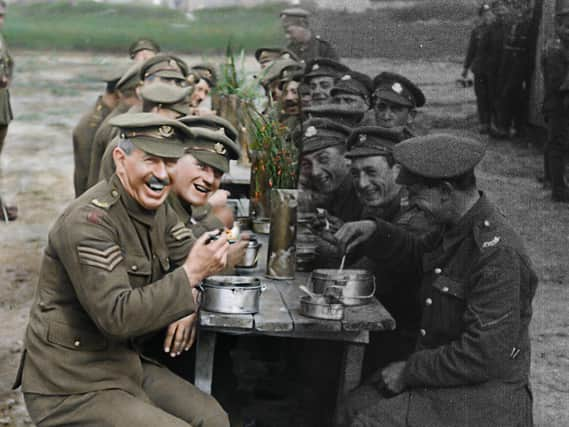Make the past less distant by colourising your old photos


That’s a slight exaggeration – his achievement in transforming grainy and jerky footage from the Western Front in 1916 into a fluid, full colour, movie called They Shall Not Grow Old, is one of the crowing achievements of cinema to date. Yet the colourisation and restoration of old black-and-white material is by no means the exclusive province of the big studios.
Artificial intelligence can now be harnessed to create colour images from faded and torn photos in your own family album. No special equipment is required, and in a historic period when we have more free days than we imagined, there may never be a better time to revisit our own history.
Advertisement
Hide AdAdvertisement
Hide AdSoftware like DeOldify allows anyone to upload pictures or even short films and re-render them in colour. Because it isn’t possible for the software to know what the original colours were, it applies logic and paints a palette it thinks might have been appropriate.
The process eliminates the meticulous colouring-in of every detail by hand, a technique that has been practiced since the earliest days of photography. Instead, the program “learns” some basic facts about the nature of the picture, such as the part of the world in which it was originated, and recognises common objects like faces, grass and the sky, then uses its imagination to colour in the rest. So it’s a best guess on what the past looked like. But, as Mr Jackson taught us, it brings the past to life more vividly and dramatically than anything else.
The developers of DeOldify and similar algorithms have mostly made them available to other programmers and sometimes placed them on public facing websites like colorize-it.com or the Singaporean colourise.sg, where you can upload pictures of your own. Both of these are one-click solutions, while www.colorizephoto.com allows some control over the process.
The technology has also been licenced to larger sites like the genealogy platform myheritage.com, which allows its members full rein. It usually takes less than 10 seconds to process each picture and the result is stored alongside the original black-and-white image, in the same resolution. My Heritage also provides an app with which you can scan your old photos while they are still in their album, using either an Android or iPhone. Pictures you have uploaded previously to your family tree can be coloured retrospectively.
Advertisement
Hide AdAdvertisement
Hide AdFinished results are marked with an icon to distinguish them from pictures that were photographed in colour in the first place, so that future researchers are not hoodwinked by such historical inaccuracies as a bright green hat on the head of the Queen Mother that was actually a subtle lilac.
You don’t need a computer to try this. Apps like Colorize Images, which use DeOldify’s technology, allow you to upload unlimited images from your phone, so long as you can tolerate the adverts.
The results won’t always be great, and for the best chance of generating something that looks realistic you will need to have an original photograph with good contrast, sharp focus and as few blemishes as possible. It also helps to choose subjects that the software can “recognise”. A wide shot of a landscape will give it fewer clues than a formal portrait.
There is, of course, no real point to this. The beauty of Peter Jackson’s work lay in restoring history, not reinventing it. But there is no denying that reframing the past in colour does make it seem a lot less distant.
Advertisement
Hide AdAdvertisement
Hide AdEditor’s note: first and foremost - and rarely have I written down these words with more sincerity - I hope this finds you well.
Almost certainly you are here because you value the quality and the integrity of the journalism produced by The Yorkshire Post’s journalists - almost all of which live alongside you in Yorkshire, spending the wages they earn with Yorkshire businesses - who last year took this title to the industry watchdog’s Most Trusted Newspaper in Britain accolade.
And that is why I must make an urgent request of you: as advertising revenue declines, your support becomes evermore crucial to the maintenance of the journalistic standards expected of The Yorkshire Post. If you can, safely, please buy a paper or take up a subscription. We want to continue to make you proud of Yorkshire’s National Newspaper but we are going to need your help.
Postal subscription copies can be ordered by calling 0330 4030066 or by emailing [email protected]. Vouchers, to be exchanged at retail sales outlets - our newsagents need you, too - can be subscribed to by contacting subscriptions on 0330 1235950 or by visiting www.localsubsplus.co.uk where you should select The Yorkshire Post from the list of titles available.
Advertisement
Hide AdAdvertisement
Hide AdIf you want to help right now, download our tablet app from the App / Play Stores. Every contribution you make helps to provide this county with the best regional journalism in the country.
Sincerely. Thank you.
James Mitchinson, Editor
Comment Guidelines
National World encourages reader discussion on our stories. User feedback, insights and back-and-forth exchanges add a rich layer of context to reporting. Please review our Community Guidelines before commenting.